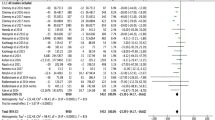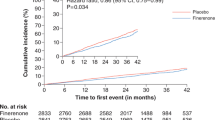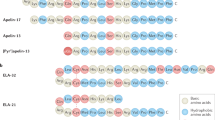Abstract
The prevalence of chronic kidney disease (CKD) is increasing worldwide. The best therapies currently available focus on the control of blood pressure and optimization of renin–angiotensin–aldosterone system blockade. Currently available agents are only partially effective against hard end points such as the development of end-stage renal disease and are not discussed in this Review. Many other agents have been shown to reduce proteinuria and delay progression in animal models of CKD. Some of these agents, including tranilast, sulodexide, thiazolidinediones, pentoxifylline, and inhibitors of advanced glycation end-products and protein kinase C, have been tested to a limited extent in humans. A small number of randomized controlled human trials of these agents have used surrogate markers such as proteinuria as end points rather than hard end points such as end-stage renal disease or doubling of serum creatinine level. Emerging therapies that specifically target and reverse pathological hallmarks of CKD such as inflammation, fibrosis and atrophy are needed to reduce the burden of this chronic disease and its associated morbidity. This Review examines the evidence for emerging pharmacological strategies for slowing the progression of CKD.
Key Points
-
Agents that block the renin–angiotensin–aldosterone system are the best of the currently available evidence-based therapies for slowing progression of chronic kidney disease (CKD), but are only partially effective
-
Many emerging therapies have shown promise in animal models of CKD, but have been less effective in humans
-
Regression of CKD in humans is rare
-
In the future, endothelin-receptor antagonists, agents that inhibit advanced glycation end-products and agents that reduce inflammation (for example, vitamin D and statins) might be useful in the treatment of human CKD
-
Experimental agents such as transforming growth factor β inhibitors, other growth factor inhibitors, small molecule inhibitors and cytokine inhibitors might also be useful in CKD in the future
-
All new therapies in CKD should be tested in conjunction with blockade of the renin–angiotensin–aldosterone system
This is a preview of subscription content, access via your institution
Access options
Subscribe to this journal
Receive 12 print issues and online access
$209.00 per year
only $17.42 per issue
Buy this article
- Purchase on Springer Link
- Instant access to full article PDF
Prices may be subject to local taxes which are calculated during checkout

Similar content being viewed by others
References
Brenner, B. M. et al. Effects of losartan on renal and cardiovascular outcomes in patients with type 2 diabetes and nephropathy. N. Engl. J. Med. 345, 861–869 (2001).
Lewis, E. J., Hunsicker, L. G., Bain, R. P. & Rohde, R.D. The effect of angiotensin-converting-enzyme inhibition on diabetic nephropathy. The Collaborative Study Group. N. Engl. J. Med. 329, 1456–1462 (1993).
The GISEN Group (Gruppo Italiano di Studi Epidemiologici in Nefrologia). Randomised placebo controlled trial of the effect of Ramipril on decline in glomerular filtration rate and risk of terminal renal failure in proteinuric, non-diabetic nephropathy. Lancet 349, 1857–1863 (1997).
Nakao, N. et al. Combination treatment of angiotensin-ll receptor blocker and angiotensin-converting-enzyme inhibitor in non-diabetic renal disease (COOPERATE): a randomised controlled trial. Lancet 361, 117–124 (2003).
Catapano, F. et al. Anti-proteinuric response to dual blockade of renin-angiotensin system in primary glomerulonephritis: meta-analysis and metaregression. Am. J. Kidney Dis. 52, 475–485 (2008).
Mann, J. F. E. et al. Renal outcomes with telmisartan, ramipril, or both, in people at high vascular risk (the ONTARGET STUDY): a multicentre randomised controlled trial. Lancet 372, 547–553 (2008).
Kelly, D. J., Zhang, Y., Gow, R. & Gilbert, R. E. Tranilast attenuates structural and functional aspects of renal injury in the remnant kidney model. J. Am. Soc. Nephrol. 15, 2619–2629 (2004).
Soma, J., Sugawara, T., Huang, Y. D., Nakajima, J. & Kawamura, M. Tranilast slows the progression of advanced diabetic nephropathy. Nephron 92, 693–698 (2002).
Soma, J., Sato, K., Saito, H. & Tsuchiya, Y. Effects of tranilast in early stage diabetic nephropathy. Nephrol. Dial. Transplant. 21, 2795–2799 (2006).
Holmes, D. R. et al. Results of Prevention of REStenosis with Tranilast and its Outcomes (PRESTO) trial. Circulation 106, 1243–1250 (2002).
Tamsma, J. T. et al. Expression of glomerular extracellular matrix components in human diabetic nephropathy: decrease of heparan sulphate in glomerular basement membrane. Diabetologia 37, 313–320 (1994).
Gambaro, G. et al. Treatment with a glycosaminoglycan formulation ameliorates experimental diabetic nephropathy. Kidney Int. 46, 797–806 (1994).
Soloni, A., Vergnani, L., Ricci, F. & Crepaldi, G. Glycosaminoglycans delay the progression of nephropathy in NIDDM. Diabetes Care 20, 819–823 (1997).
Dedov, I., Shestakova, M., Vorontzov, A. & Palazzini, E. A randomized, controlled study of sulodexide therapy for the treatment of diabetic nephropathy. Nephrol. Dial. Transplant. 12, 2295–2300 (1997).
Gambaro, G. et al. Oral sulodexide reduces albuminuria in microalbuminuric and macroalbuminuric type 1 and type 2 diabetic patients: the Di.N. A.S. randomized trial. J. Am. Soc. Nephrol. 13, 1615–1625 (2002).
Heerspink, H. L. et al. Effects of sulodexide in patients with type 2 diabetes and persistent albuminuria. Nephrol. Dial. Transplant. 23, 1946–1954 (2008).
Forbes, J. M. et al. Role of advanced glycation end products in diabetic nephropathy. J. Am. Soc. Nephrol. 14, S254–S258 (2003).
Thomas, M. C., Forbes, J. M. & Cooper, M. E. Advance glycation end products and diabetic nephropathy. Am. J. Ther. 12, 562–572 (2005).
Bolton, W. K. et al. Randomized trial of an inhibitor of formation of advanced glycation end products in diabetic nephropathy. Am. J. Nephrol. 24, 32–40 (2004).
Freedman, B. I. et al. Design and baseline characteristics for aminoguanidine clinical trial in overt type 2 diabetic nephropathy (ACTION II). Control. Clin. Trials 20, 493–510 (1999).
Forbes, J. M. et al. Renoprotective effects of a novel inhibitor of advanced glycation. Diabetologia 44, 108–114 (2001).
Miyata, T. et al. Angiotensin II receptor antagonists and angiotensin converting enzyme inhibitors lower in vitro formation of advanced glycation end products: biochemical mechanisms. J. Am. Soc. Nephrol. 13, 2478–2487 (2002).
Forbes, J. M. et al. Reduction of the accumulation of advanced glycation end products by ACE inhibition in experimental diabetic nephropathy. Diabetes 51, 3274–3282 (2002).
Williams, M. E. et al. Effects of pyridoxamine in combined phase 2 studies of patients with type 1 and type 2 diabetes and overt nephropathy. Am. J. Nephrol. 27, 605–614 (2007).
6-Month safety and efficacy study of TTP488 in patients with type 2 diabetes and persistent albuminuria [online]
Burns, W. C. et al. Connective tissue growth factor plays an important role in advanced glycation end product induced-tubular epithelial-to-mesenchymal transition: implications for diabetic renal disease. J. Am. Soc. Nephrol. 17, 2484–2494 (2006).
Adler, S. G. et al. Dose-escalation phase 1 study of FG-3019, anti-CTGF monoclonal antibody, in subjects with type I/II diabetes mellitus and microalbuminuria. J. Am. Soc. Nephrol. 17, 157A (2006).
Peppa, M. et al. Prevention and reversal of diabetic nephropathy in db/db mice treated with Alagebrium (ALT-711). Am. J. Nephrol. 26, 430–436 (2006).
Coughlan, M. T. et al. Role of the AGE crosslink breaker, alagebrium, as a renoprotective agent in diabetes. Kidney Int. 72, S54–S60 (2007).
Zieman, S. J. et al. Advanced glycation end product crosslink breaker (alagebrium) improves endothelial function in patients with isolated systolic hypertension. J. Hypertens. 25, 577–583 (2007).
Swaminathan, S. & Shah, S. V. Novel approaches targeted toward oxidative stress for the treatment of chronic kidney disease. Curr. Opin. Nephrol. Hypertens. 17, 143–148 (2008).
Tuttle, K. R. et al. The effect of ruboxistaurin on nephropathy in type 2 diabetes. Diabetes Care 28, 2686–2690 (2005).
Tuttle, K. R. et al. Kidney outcomes in long-term studies of ruboxistaurin for diabetic eye disease. Clin. J. Am. Soc. Nephrol. 2, 631–636 (2007).
Agarwal, R. et al. A pilot randomized controlled trial of renal protection with pioglitazone in diabetic nephropathy. Kidney Int. 68, 285–292 (2005).
Bakris, G. L. et al. Rosiglitazone reduces microalbuminuria and blood pressure independently of glycemia in type 2 diabetes patients with microalbuminuria. J. Hypertens. 24, 2047–2055 (2006).
Kincaid-Smith, P., Fairley, K. F., Farish, S., Best, J. D. & Proietto, J. Reduction of proteinuria by rosiglitazone in non-diabetic renal disease. Nephrology (Carlton) 13, 58–62 (2008).
Pistrosch, F. et al. Rosiglitazone improves glomerular hyperfiltration, renal endothelial dysfunction and microalbuminuria of incipient diabetic nephropathy in patients. Diabetes 54, 2206–2211 (2005).
Guo, B. et al. Peroxisome proliferator-activated receptor-γ ligands inhibit TGF-β1-induced fibronectin expression in glomerular mesangial cells. Diabetes 53, 200–208 (2004).
Nissen, S. E. & Wolski, K. Effect of rosiglitazone on the risk of myocardial infarction and death from cardiovascular causes. N. Engl. J. Med. 356, 2457–2471 (2007).
Home, P. et al. Rosiglitazone evaluated for cardiovascular outcomes—an interim analysis. N. Engl. J. Med. 357, 28–38 (2007).
Chen, Y. M., Lin, S. L., Chiang, W. C., Wu, K. D. & Tsai, T. J. Pentoxifylline ameliorates proteinuria through suppression of renal monocyte chemoattractant protein-1 in patients with proteinuric primary glomerular diseases. Kidney Int. 69, 1410–1415 (2006).
Navarro, J. F., Mora, C., Muros, M. & García, J. Additive anti-proteinuric effect of pentoxifylline in patients with type 2 diabetes under angiotensin-2 receptor blockade: a short-term, randomized, controlled trial. J. Am. Soc. Nephrol. 16, 2119–2126 (2005).
Lin, S. L., Chen, Y. M., Chiang, W. C., Wu, K. D. & Tsai, T. J. Effect of pentoxifylline in addition to losartan on proteinuria and GFR in CKD: a 12 month randomized trial. Am. J. Kidney Dis. 52, 464–474 (2008).
McCormick, B. B. et al. The effect of pentoxifylline on proteinuria in diabetic kidney disease: a meta-analysis. Am. J. Kidney Dis. 54, 454–463 (2008).
Barton, M. Reversal of proteinuric renal disease renal disease and the emerging role of endothelin. Nat. Clin. Pract. Nephrol. 4, 490–501 (2008).
Morigi, M. et al. Shigatoxin-induced endothelin-1 expression in cultured podocytes autocrinally mediates actin remodeling. Am. J. Pathol. 169, 1965–1975 (2006).
Morigi, M. et al. In response to protein load podocytes reorganize cytoskeleton and modulate endothelin-1 gene: implication of permselective dysfunction of chronic nephropathies. Am. J. Pathol. 166, 1309–1320 (2005).
Opocensky, M. et al. Late onset endothelin-A receptor blockade reduces podocyte injury in homozygous Ren-2 rats despite severe hypertension. Hypertension 48, 965–971 (2006).
Ortmann, J. et al. Role of podocytes for reversal of glomerulosclerosis and proteinuria in ageing the kidney after endothelin inhibition. Hypertension 44, 974–981 (2004).
Honing, M. L. et al. Selective ETA receptor antagonism with ABT-627 attenuated all renal effects of endothelin in humans. J. Am. Soc. Nephrol. 11, 1498–1504 (2000).
Wenzel, R. R. et al. Avosentan reduces albumin excretion in diabetics with microalbuminuria. J. Am. Soc. Nephrol. 20, 655–664 (2009).
Viberti, G. SPP301 (avosentan) ASCEND clinical results [online] (2008).
Black, H. R. et al. Efficacy and safety of darusentan in patients with resistant hypertension: results from a randomized, double-blind, placebo-controlled dose-ranging study. J. Clin. Hypertens. (Greenwich) 9, 760–769 (2007).
Campese, V. M., Nadim, M. K. & Epstein, M. Are 3-hydroxy-3-methylglutaryl-coA reductase inhibitors renoprotective? J. Am. Soc. Nephrol. 16, S11–S17 (2005).
Athyros, V. G. et al. The effects of statins versus untreated dyslipidemia on renal function in patients with coronary heart disease. A subgroup analysis of the Greek atorvastatin and coronary heart disease evaluation (GREACE) study. J. Clin. Pathol. 57, 728–734 (2004).
Sandhu, S., Wiebe, N., Fried, L. F. & Tonelli, M. Statins for improving renal outcomes: a meta-analysis. J. Am. Soc. Nephrol. 16, 2006–2016 (2006).
Douglas, K., O'Malley, P. G. & Jackson, J. L. Meta-analysis: The effect of statins on albuminuria. Ann. Intern. Med. 145, 117–124 (2006).
Strippoli, G. F. et al. Effects of statins in patients with chronic kidney disease: Meta-analysis and meta-regression of randomised controlled trials. BMJ 336, 645–651 (2008).
Kuriyama, S. et al. Reversal of anemia by erythropoietin therapy retards progression of chronic kidney failure, especially in nondiabetic patients. Nephron 77, 176–185 (1997).
Gouva, C., Nikolopoulos, P., Ioannidis, J. P. & Siamopoulos, K. C. Treating anemia early in renal failure patients slows the decline of renal function: a randomized controlled trial. Kidney Int. 66, 753–760 (2004).
Drüeke, T. B. et al. Normalization of hemoglobin level in patients with chronic kidney disease and anemia. N. Engl. J. Med. 355, 2071–2084 (2006).
Singh, A. K. et al. Correction of anemia with epoetin alpha in chronic kidney disease. N. Engl. J. Med. 355, 2085–2098 (2006).
Carlini, R. G. et al. Effect of recombinant human erythropoietin on endothelial cell apoptosis. Kidney Int. 55, 546–553 (1999).
Pfeffer, M. A. Critical missing data on erythropoiesis-stimulating agents in CKD: first beat placebo. Am. J. Kidney Dis. 51, 366–369 (2008).
Szeto, C. C. et al. Oral calcitriol for the treatment of persistent proteinuria in IgA nephropathy: an uncontrolled trial. Am. J. Kidney Dis. 51, 724–731 (2008).
Agarwal, R. et al. Antiproteinuric effect of oral paricalcitol in chronic kidney disease. Kidney Int. 68, 2823–2828 (2005).
Alborzi, P. et al. Paricalcitol reduces albuminuria and inflammation in patients with chronic kidney disease: a randomized double-blind pilot trial. Hypertension 52, 249–255 (2008).
Shoben, A. B. et al. Association of oral calcitriol with improved survival in nondialyzed CKD. J. Am. Soc. Nephrol. 19, 1613–1619 (2008).
Shillingford, J. M. et al. The m-TOR pathway is regulated by polycystin-1 and its inhibition reverses renal cystogenesis in polycystic kidney disease. Proc. Natl Acad. Sci. USA 103, 5466–5471 (2006).
Qian, Q. et al. Sirolimus reduces polycystic liver volume in ADPKD patients. J. Am. Soc. Nephrol. 19, 631–638 (2008).
Tao, Y. et al. Pathways of caspase-mediated apoptosis in autosomal dominant polycystic kidney disease (ADPKD). Kidney Int. 67, 909–919 (2005).
Edelstein, C. L. Mammalian target of rapamycin and caspase inhibitors in polycystic kidney disease. Clin. J. Am. Soc. Nephrol. 3, 1219–1226 (2008).
Torres, V. E. Role of vasopressin antagonists. Clin. J. Am. Soc. Nephrol. 3, 1212–1218 (2008).
Chapman, A. B. Autosomal dominant polycystic kidney disease: time for a change? J. Am. Soc. Nephrol. 18, 1399–1407 (2007).
Gattone, V. H., Wang, X., Harris, P. C. & Torres, V. E. Inhibition of renal cystic disease development and progression by a vasopressin V2 receptor antagonist. Nat. Med. 9, 1323–1326 (2003).
Torres, V. E. et al. Phase 2 open label study to determine long term safety, tolerability and efficacy of split-dose tolvaptan in ADPKD [abstract]. J. Am. Soc. Nephrol. 18, 361A–362A (2007).
Torres, V. E. et al. “TEMPO 3/4 Trial” tolvaptan efficacy and safety in the management of polycystic kidney disease and its outcomes (TEMPO3/4) [online] (2008).
Ruggenenti, P. et al. Safety and efficacy of long-acting somatostatin treatment in autosomal dominant polycystic kidney disease. Kidney Int. 68, 206–216 (2005).
Wang, S. et al. Renal bone morphogenic protein-7 protects against diabetic nephropathy. J. Am. Soc. Nephrol. 17, 2504–2512 (2006).
Zeisberg, M. et al. Bone morphogenic protein-7 inhibits progression of chronic renal fibrosis associated with two genetic mouse models. Am. J. Physiol. Renal Physiol. 285, F1060–F1067 (2003).
Jung, D. S. et al. FR167653 inhibits fibronectin expression and apoptosis in diabetic glomeruli and in high-glucose-stimulated mesangial cells. Am. J. Physiol. Renal Physiol. 295, F595–F604 (2008).
Ninichuk, V. et al. Multipotent mesenchymal stem cells reduce interstitial fibrosis but do not delay progression of chronic kidney disease collagen 4A3-deficient mice. Kidney Int. 70, 121–129 (2006).
Ohtake, T. et al. Pathological regression by angiotensin ll type 1 receptor blocker in patients with mesangial proliferative glomerulonephritis. Hypertens. Res. 31, 387–394 (2008).
Author information
Authors and Affiliations
Corresponding author
Ethics declarations
Competing interests
The authors declare no competing financial interests.
Rights and permissions
About this article
Cite this article
Vilayur, E., Harris, D. Emerging therapies for chronic kidney disease: what is their role?. Nat Rev Nephrol 5, 375–383 (2009). https://doi.org/10.1038/nrneph.2009.76
Published:
Issue Date:
DOI: https://doi.org/10.1038/nrneph.2009.76
This article is cited by
-
Orally active, species-independent novel A3 adenosine receptor antagonist protects against kidney injury in db/db mice
Experimental & Molecular Medicine (2018)
-
Protective effect of epigallocatechin-3-gallate (EGCG) via Nrf2 pathway against oxalate-induced epithelial mesenchymal transition (EMT) of renal tubular cells
Scientific Reports (2016)
-
Emerging Agents for the Management of Nephrotic Syndrome: Progress to Date
Pediatric Drugs (2016)
-
What is the best way to measure renal fibrosis?: A pathologist’s perspective
Kidney International Supplements (2014)



